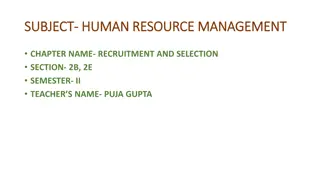Strategic Management Course - Strategy Generation and Selection Techniques
This content covers the essential techniques in strategy generation and selection in the field of strategic management. It includes key frameworks such as the Strategy-Formulation Analytical Framework, Grand Strategy Matrix, and tools like SWOT analysis and QSPM. The emphasis is on how strategists can identify, evaluate, and choose appropriate strategies to help organizations achieve their missions and objectives effectively.
Download Presentation

Please find below an Image/Link to download the presentation.
The content on the website is provided AS IS for your information and personal use only. It may not be sold, licensed, or shared on other websites without obtaining consent from the author.If you encounter any issues during the download, it is possible that the publisher has removed the file from their server.
You are allowed to download the files provided on this website for personal or commercial use, subject to the condition that they are used lawfully. All files are the property of their respective owners.
The content on the website is provided AS IS for your information and personal use only. It may not be sold, licensed, or shared on other websites without obtaining consent from the author.
E N D
Presentation Transcript
Strategic Management Course Fourth year, English program Week 10, Lecture10 Dr/ Sally Amer 15/4/2020
Chapter 8 Strategy Generation and Selection Part Two
Learning Objectives 1) How to select strategies to pursue? 2) How to design the strategy analysis and choice seek to determine alternative courses of action that could best enable the firm to achieve its mission and objectives?
The Strategy-Formulation Analytical Framework Important strategy-formulation techniques can be integrated into a three-stage framework. The tools presented in this framework are applicable to all sizes and types of organizations and can help strategists identify, evaluate, and select strategies. Stage 1 of the strategy-formulation analytical framework consists of; The External Factor Evaluation (EFE) Matrix. The Internal Factor Evaluation (IFE) Matrix. The Competitive Profile Matrix (CPM). Stage 1 Called the input stage, Stage 1 summarizes the basic input information needed to formulate strategies. decision-making
The Strategy-Formulation Analytical Framework Stage 2, called the matching stage, focuses on generating feasible alternative strategies by aligning key external and internal factors. Stage 2 techniques include ; The Strengths-Weaknesses-Opportunities-Threats Matrix. The Strategic Position and Action. Evaluation (SPACE) Matrix. The Boston Consulting Group (BCG) Matrix. The Internal-External (IE) Matrix. The Grand Strategy Matrix. (SWOT) Stage 3, called the decision stage, involves a single technique, the Quantitative Strategic Planning Matrix (QSPM). A QSPM uses input information from Stage 1 to objectively evaluate feasible alternative strategies identified in Stage 2.
The Grand Strategy Matrix The Grand Strategy Matrix has become a popular tool for formulating alternative strategies. All organizations can be positioned in one of the Grand Strategy Matrix s four strategy quadrants. A firm s divisions likewise could be positioned. The Grand Strategy Matrix is based on two evaluative dimensions: 1) competitive position on the x-axis 2) market (industry) growth on the y-axis. Any industry whose annual growth in sales exceeds 5 percent could be considered to have rapid growth. Appropriate strategies for an organization to consider are listed in sequential order of attractiveness in each quadrant of the Grand Strategy Matrix.
The Grand Strategy Matrix (Cont.) Firms located in Quadrant I of the Grand Strategy Matrix are in an excellent strategic position. For these companies, continued concentration on current markets (market penetration and market development) and products (product development) is an appropriate strategy. When a Quadrant I organization has excessive resources, then backward, forward, or horizontal integration may be effective strategies.
Quadrant I When a Quadrant I firm is too heavily committed to a single product, then related diversification may reduce the risks associated with a narrow product line. Quadrant I firms can afford to take advantage of external opportunities in several areas. They can take risks aggressively when necessary.
Quadrant II Firms positioned in Quadrant II need to evaluate their present approach to the marketplace seriously. Although their industry is growing, they are unable to compete effectively; they need to determine why the firm s current approach is ineffective and how the company can best change to improve its competitiveness. Because Quadrant II organizations are in a rapid market growth industry, an intensive strategy (as opposed to integrative or diversification) is usually the first option that should be considered.
Quadrant II However, if the firm is lacking a distinctive competence or competitive advantage, then horizontal integration is often a desirable alternative. As a last resort, divestiture or liquidation should be considered. Divestiture can provide funds needed to acquire other businesses or buy back shares of stock.
Quadrant III Quadrant III organizations compete in slow-growth industries and have weak competitive positions. These firms must make some drastic changes quickly to avoid further decline and possible liquidation. Extensive cost and asset reduction (retrenchment) should be pursued first. An alternative strategy is to shift resources away from the current business into different areas (diversify). If all else fails, the final options for Quadrant III businesses are divestiture or liquidation.
Quadrant IV Finally, Quadrant IV businesses have a strong competitive position but are in a slow-growth industry. These firms have the strength to launch diversified programs into more promising growth areas: Quadrant IV businesses have characteristically high cash-flow levels and limited internal growth needs and often can pursue related or unrelated diversification Quadrant IV firms also may pursue joint ventures. successfully.
The Decision Stage: The Quantitative Strategic Planning Matrix (QSPM) The Quantitative Strategic Planning Matrix (QSPM), which comprises Stage 3 of the strategy-formulation analytical framework, objectively indicates strategies are best. which alternative The QSPM uses input from Stage 1 analyses and matching results from Stage 2 analyses to decide objectively among alternative strategies. That is, the EFE Matrix, IFE Matrix, and CPM that comprise Stage 1, coupled with the SWOT Matrix, SPACE Matrix, BCG Matrix, IE Matrix, and Grand Strategy Matrix that comprise Stage 2, provide the needed information for setting up the QSPM (Stage 3).
The Decision Stage: The Quantitative Strategic Planning Matrix (QSPM) (Cont.) The QSPM is a tool that allows strategists to evaluate alternative strategies objectively, based on previously identified external and internal key success factors. Like other strategy-formulation analytical tools, the QSPM requires assignment of ratings (called attractiveness scores), but making small rating decisions enables strategists to make effective big decisions, such as which country to spend a billion dollars in to sell a product.
The Decision Stage: The Quantitative Strategic Planning Matrix (QSPM) (Cont.) The QSPM determines the relative attractiveness of various strategies based on the extent that key external and internal factors are capitalized on or improved. The relative attractiveness of each strategy within a set of alternatives is computed by determining the cumulative impact of each external and internal factor. Any number of sets of alternative strategies can be included in the QSPM, and any number of strategies can make up a given set, but only strategies within a given set are evaluated relative to each other.
Steps required to develop a QPSM There are six steps required to develop a QSPM are discussed: Step 1: Make a list of the firm s key external opportunities and threats and internal strengths and weaknesses in the left column of the QSPM. This information should be taken directly from the EFE Matrix and IFE Matrix. Step 2: Assign weights to each key external and internal factor. These weights are identical to those in the EFE Matrix and IFE Matrix. (The weights are presented in a straight column just to the right of the external and internal factors).
Steps required to develop a QPSM Step 3: Examine the Stage 2 (matching) matrices, and identify alternative strategies that the implementing. Record these strategies in the top row of the QSPM. Group the strategies into mutually exclusive sets if possible. organization should consider Step 4: Determine the Attractiveness Scores (AS), defined as numerical values that indicate the relative attractiveness of each strategy considering a single external or internal factor. Attractiveness Scores (AS) are determined by examining each key external or internal factor, one at a time, and asking the question,
Steps required to develop a QPSM (Cont.) Does this factor affect the choice of strategies being made? If the answer to this question is yes, then the strategies should be compared relative to that key factor. Specifically, AS should be assigned to each strategy to indicate the relative attractiveness of one strategy over others, considering the particular factor. The range for AS is 1 = not attractive, 2 = somewhat attractive, 3 = reasonably attractive, and 4 = highly attractive. By attractive, we mean the extent that one strategy, compared to others, enables the firm to either capitalize on the strength, improve on the weakness, exploit the opportunity, or avoid the threat. If the answer to the previous question is no, indicating that the respective key factor has no effect on the specific choice being made, then do not assign AS to the strategies in that set.
Steps required to develop a QPSM (Cont.) Step 5: Compute the Total Attractiveness Scores. Total Attractiveness Scores (TAS) are defined as the product of multiplying the weights (Step 2) by the AS (Step 4) in each row. The TAS indicate the relative attractiveness of each alternative strategy, considering only the impact of the adjacent external or internal critical success factor. The higher the TAS, the more attractive the strategic alternative. Step 6: Compute the Sum Total Attractiveness Score. Add TAS in each strategy column of the QSPM. The Sum Total Attractiveness Scores (STAS) reveal which strategy is most attractive in each set of alternatives. Higher scores indicate more attractive strategies, considering all the relevant external and internal factors that could affect the strategic decisions. The magnitude of the difference between the STAS in a given set of strategic alternatives indicates the relative desirability of one strategy over another.























